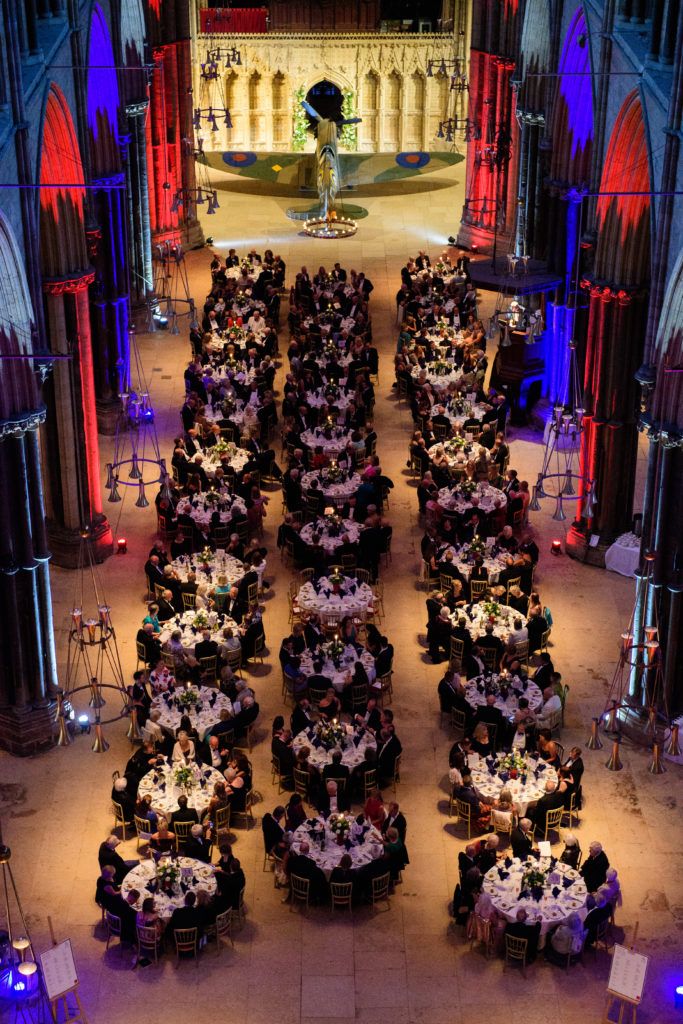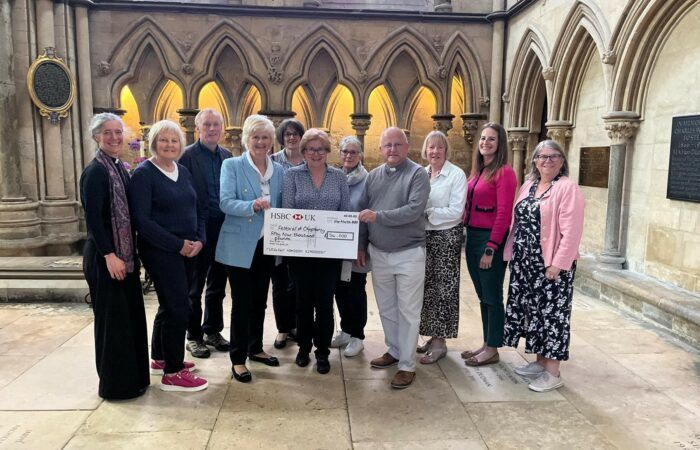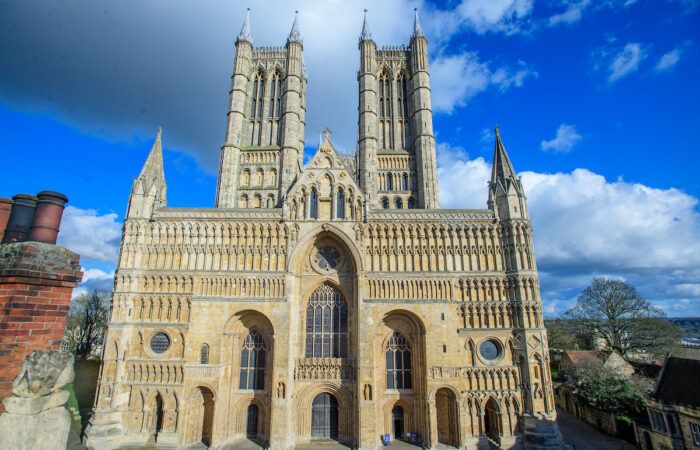Welcome by AVM Canon Paul Robinson OBE FRAeS
Lord Lieutenant, Madam Dean, Ladies and Gentlemen;
I’m Paul Robinson; I sit on the Cathedral Chapter and the Management Board of the International Bomber Command Centre and I’m a long-time member of the RAF: over 50 years I’m surprised to say – half the RAF’s history. So the Cathedral’s Events team – and haven’t they done a superb job tonight – thought it appropriate for me, on behalf of the Dean and Chapter, to welcome you all to this historic occasion, and to warm you up prior to the Dean’s Grace. But first I’m obliged to give the mandatory safety brief; here goes:
“Bing-bong: our Captain, Wing & a Prayer Commander ‘Deano’ Wilson and her crew welcome you aboard Cathedral Squadron Flight RAF 100; to celebrate 100 years of deafening noise over Lincolnshire. Please make sure (particularly you ladies) that your baggage is stowed under your seat to allow the cabin staff access around the tables. More wine can be provided: please ask your steward and don’t forget to have your credit card ready. In the unlikely event we need to evacuate the Nave, the emergency exits are here … and here: just follow the staff’s instructions and don’t panic. Life jackets are not under your seats – we think the chances of landing in Brayford Pool are pretty small; which is lucky because you need the space for your handbags. We hope you have a pleasant flight; and that you’ll fly Cathedral Squadron for all your future big theological and social events. Bing bong!”
Seriously; I don’t need to explain the significance of the RAF to a Lincolnshire audience, and why the Service is woven into County life. By virtue of geography, geology, topography; have been so many RAF bases here, it was said that if a pilot closed eyes and landed blind, he’d land on an airfield. Fighter bases like Digby and Binbrook; training schools like Cranwell and Spitalgate); then there’s the Coastal Command stations at North Coates and Strubby); the Wainfleet and Holbeach bombing ranges; hospitals at Nocton and Rauceby; even nuclear missiles based at Hemswell and Folkingham); and, above all, bomber airfields like Waddington, Scampton, Coningsby and Faldingworth.
Most Lincolnshire families have an RAF connection. In this room tonight, there’s someone whose father was a Mosquito night-fighter/intruder pilot; another who flew night low-level sorties in a Tornado against Iraq airfields during the first Gulf War; and someone whose uncle was awarded a posthumous VC in 1941, piloting a Blenheim bomber in the Far East; and who also maintains a memorial to a crew whose Stirling bomber which was shot down and crashed on the family farm.
And of course the Service has always had close links with the Cathedral. From 1000ft you can see the Cathedral from almost every corner of our County. Bomber crews said it was the last place they saw heading east, and on their return the lucky ones used it as a beacon to find home: find the Cathedral, then fly a bearing and distance to your airfield. And it was not just a geographical beacon. As described in the book ‘Battle Order 204’, David Mattingley, a 22 year-old Australian, was a Lancaster pilot on 425 Squadron at RAF Kelstern, near Grimsby. Badly wounded over Germany and recuperating at Rauceby, Boxing Day 1944 found him and his brother Brian visiting a foggy Lincoln. They walked up Steep Hill, and I quote: “Then suddenly, as they reached the top, they emerged from the fog to see the Cathedral, in all its ancient splendour, bathed in sunshine. David caught his breadth. It seemed an epiphany; an allegory of the triumph of light over darkness. Entering through the Great West Door, they paused to take in the sweep of the lofty arches with the light streaming through the windows above; and his soul sang with the glory of the great church, hallowed by worship for almost a thousand years. As they sat quietly in the Nave, the sound of the mighty organ rolled forth; reverberating through them like a score of Merlin engines. Then, from the exquisitely-carved Angel Choir, voices soared in the powerful anthems of Handel’s Messiah. David felt washed, bathed, soaked, steeped in its healing affirmation. He truly knew that his Redeemer lived and, whatever might happen, held him in His almighty love.” This beacon of spiritual faith still holds good for today’s young RAF men & women.
Again, the Cathedral has its Airmen’s Chapel, with its stained glass windows, its laid-up standards with their battle honours, and – most moving – three Bomber Command Rolls of Honour, containing the names of 25,611 young aircrew who were killed flying bombers from Lincolnshire airfields during WW2, nearly half of the Command’s total losses of 55,573. Not for nothing is Lincolnshire known as ‘Bomber County’. The sacrifice of those aircrew was truly heroic: all volunteers, 55% lost their lives during their first tour of 30 operations; a casualty rate higher than that for infantry subalterns on the trenches of WW1. Only 27% of bomber aircrew survived the War physically unscathed. It was their willing sacrifice that inspired our Past Lord-Lieutenant, Tony Worth, to found the International Bomber Command Centre. Most of you will have seen its Spire; some will have visited the Centre, and seen the Memorial Walls which display the names of all 57,871 aircrew and ground staff who lost their lives. If you haven’t seen it – go; and prepare to be moved.
Of course, there’s always a ‘but’. For the IBCC, it’s fund-raising. We had to borrow to finish the project in swift order, and we still have to raise £2m. So we’re most grateful to the Cathedral, which has its own fund-raising concerns, for sharing any profits from tonight. This will include the proceeds from one of the auction items – so please dig deep when William Gregory puts the bite on you later. And don’t forget the Prize Draw: on your table there are gift aid envelopes. These are your draw tickets: fill in your details, seed them with money ‘that crinkles, not tinkles’ and we’ll collect them later.
An Army colleague once told me that the RAF isn’t old enough to have traditions, only habits. I would disagree. Throughout the last 100 years of continuous operations, the RAF’s air and ground crews have led the way in Meritocracy and Diversity; proved adept at utilising cutting-edge technology; time and again displayed tactical innovation and imagination; and served our Country with loyalty, dedication, tenacity & courage. And I’m sure even my Army friend would admit my Service has now earned its spurs.
Ladies and Gentlemen: Lincolnshire is the RAF’s County; this Cathedral is the RAF’s Cathedral; and it’s an honour and pleasure for me to welcome you here tonight, to celebrate ‘RAF100’. I hope you have a super evening. And the next 100 years? Only look to our motto: “Per Ardua ad Astra.”
And now, please welcome the Dean, who will say Grace.
[separator]
The Dean of Lincoln, the Very Reverend Christine Wilson said Grace.
[separator]
Address by Mr Sidney McFarlane MBE, Trustee, IBCC
The Very Reverend Christine Wilson and distinguished guests, ladies and gentlemen. Thank you for that kind introduction and thank you for inviting me to join you and your guests to celebrate 100 years history of the RAF. I am delighted and honoured to be here tonight, to speak about the International Bomber command Centre; but before doing so, I consider it appropriate to highlight the fact that without the RAF100 experience, I wouldn’t be standing here tonight. I would not have had the resources which provided the opportunity for our three sons to have benefited from university education and successful careers. Some of you may have met Colin my youngest son, who by all accounts is a successful actor.
But how did I become part of the proud history of the of the RAF? Soon after my arrival from Jamaica in June 1955 I was instructed by the then National Assistance Board, that I had to be registered for National Service, which I strongly resisted, but was told that under the National Service Act 1948, migrants from British colonies that had not yet gained independence is deemed to be as British as the indigenous population and therefore I was eligible for National service. Neither the RAF, the Army nor the Royal Navy were my first choice for employment. However, I had no option and having chose the RAF, I went in kicking and screaming transferred to regular service and served for 30 years. As part of the Windrush generation it has been particularly painful and sad that such distress had been experienced by British citizens, who have made enormous contribution to this country, in having to prove their status, which should never have been the case.
Turning now to the journey of the IBCC. The Trust was set up in 2009 by the then chairman, the late Tony Worth, former Lord Lieutenant.
Sadly, he passed away before completion of the Chadwick centre. Tony’s father and two uncles served in the command, and he wanted to ensure that all those involved in Bomber Command were recognised and remembered in “Bomber County”, and that Lincolnshire’s great contribution to the war effort was also acknowledged.
As trustees, we faced numerous challenges, the greatest of which was finance. How to persuade external funders and the general public to
believe in the project sufficiently to fund the construction based solely on a concept. Funding presented, and continues to be, the most difficult challenge to overcome. We had a very small but dedicated staff team supported by an army of volunteers, who worked tirelessly to promote the project, working almost every weekend throughout the summer months covering shows and events.
The University of Lincoln joined us in 2014 and are our partners in the development of the Digital Archive, now the core part of the Chadwick centre. In 2016 following a successful funding bid to the Heritage Lottery, we were awarded a grant of £3.2 million over five years specifically for this part of the project. October 2nd, 2015 saw the unveiling of the Memorial Spire and walls, at which 312 veterans were joined by 2,500 other guests.
The International Bomber Command Centre (IBCC), will serve as a point of recognition, remembrance and reconciliation for those who served, supported and suffered the bombing campaigns during WW2. Providing one of the most comprehensive records of the Command in the world; the IBCC ensures generations to come can learn of the vital role in protecting the freedom we enjoy today and will never forget. Education lies at the heart of everything we do – not just the formal and educational visits but, communities, adult learners and families. Last Month we received the delightful news from the Heritage Education Trust that the IBCC had won its first Sandford Award, which is quite remarkable given our recent creation. We have also, been asked to host the related Award ceremony later in the year.
There are three elements to the IBCC; first is the Chadwick Centre that brings to life, the experience of those involved in
the Command. It uses state-of-the-art technology and inter-active displays throughout to tell the story of Bomber Command, through the eyes of people who actively experienced it. There are three exhibition galleries, reference and research libraries, an extensive programme of events,
a HUB Café and a shop with souvenirs. Thus far the IBCC has recorded over 1000 interviews, mostly with veterans and other eye witnesses; and we have digitised over 1600 collections of personal memorabilia, varying from a few photos to a few suitcases of material. We will be online, free to use from 5 September. As it takes a huge amount of time to prepare digitised material for publication, we will have about 25% of all our material online by 5 Sep, and will steadily add the rest. People across the world will have free and searchable access to thousands of the memories, letters, diaries, service documents and photos that combine to form the heritage of Bomber Command.
The second element of the Centre is the Peace gardens. This offers 10 acres of landscaped grounds with quiet contemplative space, and 27 native trees marking each of the operational Bomber Command stations in Lincolnshire. There is also recognition of the 62 nations and five continents involved in supporting the Command.
The third element is the Memorial Spire and walls. The Spire is the UK’s tallest War Memorial at 102ft or 31.09m. The same height as the wingspan of a Lancaster Bomber. The walls surrounding the Spire, which hold the names of nearly 58,000 men and women, provide the only place in the world to memorialise all lives lost from the Command.
The support both financially and in kind that the Trust has attracted locally, nationally and internationally has been remarkable, as is the support of those who have given so freely of their time, and without that help the project would not have got off the ground. In addition to grant from the
Heritage Lottery, grants have also been awarded from a range of different grant-making bodies, including, Veolia, the Community Covenant, Garfield Weston, the Foyle Foundation, the Big Lottery Fund, LIBOR, LEAP, and our constant supporter North Kesteven District Council. The members of the public have made individual donations totalling a fantastic £5.5 million, over the last 5 years.
There is still some way to go to raise all the funds needed to complete the Project, and to ensure that the Archive, community engagement, and
education programmes are well supported. Any donation receive tonight will be used to go towards the £1.5 million we still need to raise to finish paying for the building. To enable us to start generating an income it was paramount that we got the Centre open. This has enabled us to develop our community engagement programme, and we are now working with the Duke of Edinburgh Awards, Scouting and Guiding groups, Schools, elderly care centres and the Armed services. ensure that the Archive, community engagement and education programmes are well supported for the future.
We have 742 volunteers, who come from 9 different countries who are involved in an enormous range of tasks, each contributing to make the Project happen and flourish. One of our volunteers, Dave Gilbert has put in over 5,000 hours of volunteer time to ensure each of these 57,861 names on the memorial walls were correctly remembered and honoured.
The Centre initially opened to the public on 30 January 2018. This was then followed by the official opening on 12th April, 2018 as part of the RAF 100 Anniversary celebrations, and was attended by 4,441 people including 308 veterans. Thus far, more than 31,000 people have visited from all over the world. Visitors can come to the Centre and spend time in the gardens and at the Spire for free. However, there is a charge to visit the exhibition.
We are running a comprehensive events programme and are delighted to be hosting many events, including the Sandford Awards ceremony, over the next year.
Finally, this is not a government funded project and every ticket purchase and donation help keep every memory alive for the next generation. Thanks for listening.

Lincoln Cathedral hosted the RAF 100 dinner on Friday 10, August 2018.

